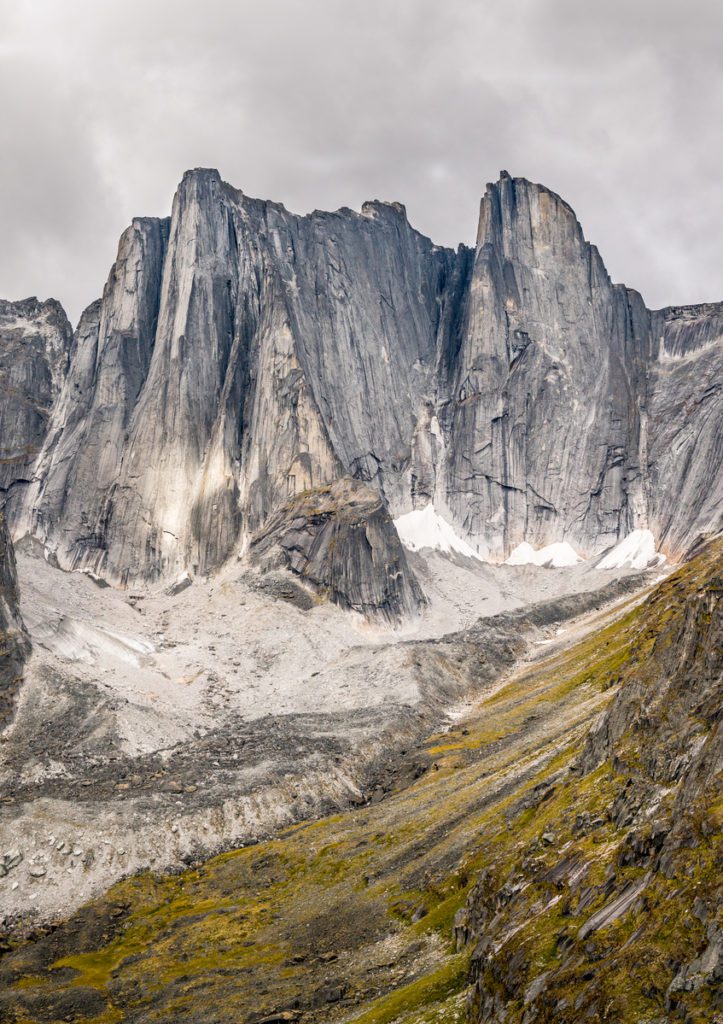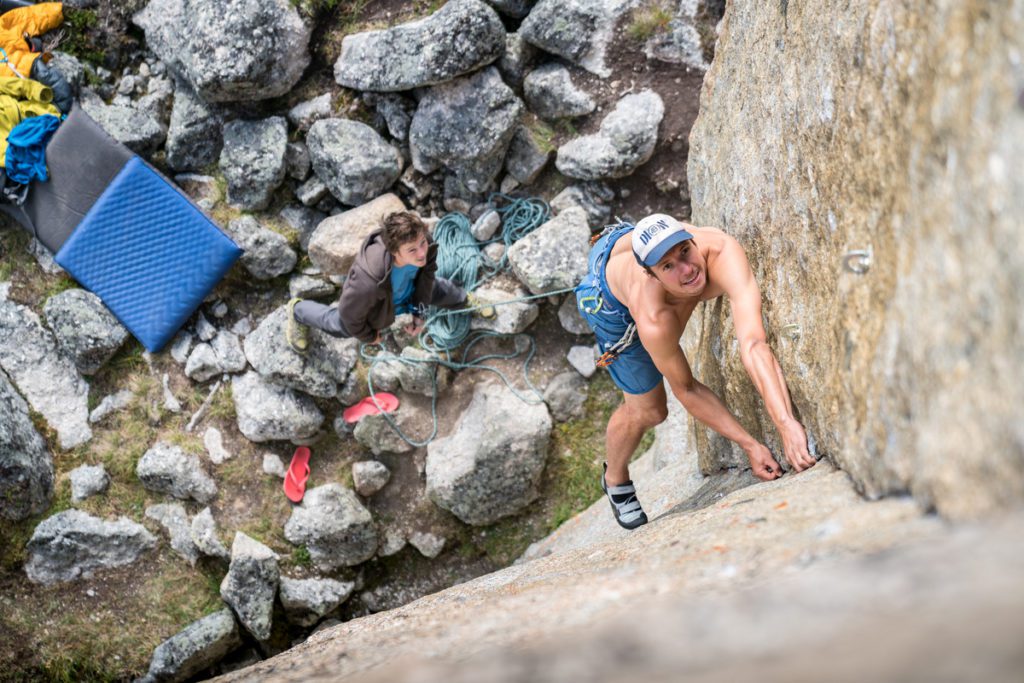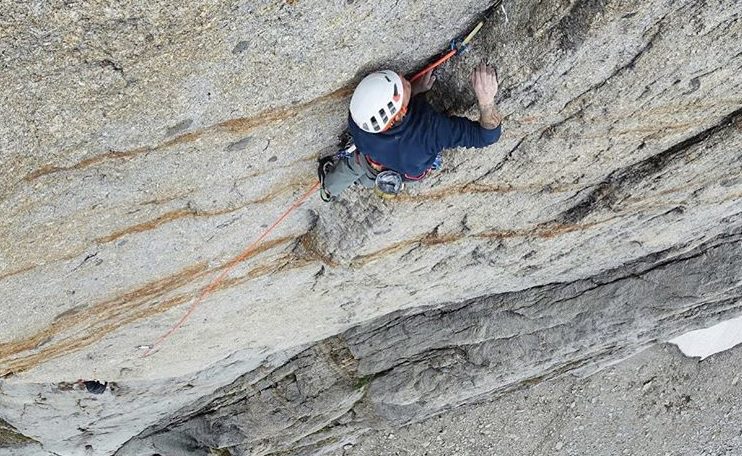Editor’s Note: All National Parks in Canada are currently closed due to the coronavirus outbreak, but once they reopen, the Cirque of the Unclimbables should be at the top of your bucket list.
“The Knife sticks 10 to 15 metres out from the wall and runs the entire height. Because we were so far from the rest of the wall on the Knife, we were able to climb with minimal amounts of falling ice and rocks hitting us. Every night, the top of the wall would freeze up and then for the rest of the next day, it would all fall off. So, the Knife seemed like the best option for self-preservation.” –Sam Eastman, attempting an ascent on the Great Canadian Knife in 2019.
As climber Sam Eastman and his party discovered, The Cirque of the Unclimbables in Nahanni National Park Reserve offers some of the best and most challenging granite rock climbing in Canada. It’s located just over the western border of the Northwest Territories. There are no roads within 150 kilometres and you can only access the area by air or water.
The Cirque has world-class big wall climbs as fine as those of BC’s Bugaboos, but without the glaciers and snow. Lotus Flower Tower and Mount Proboscis are the most sought-after peaks. The best times to visit are mid-to-late summer as there can be up to 20 hours of daylight.
Fairy Meadows is the traditional basecamp for most routes except the more remote Mount Proboscis. Over the years, bouldering problems and even some bolted sport routes have been added to the Meadows.

Nahanni National Park Reserve
Nahanni National Park Reserve (Nah?ą Dehé) is a UNESCO World Heritage Site. There are sheer granite spires, vast alpine plateaus and, at its heart, the South Nahanni, a Canadian Heritage River.
Parks Canada notes: “This great-spirit water thunders at Náįlįcho (Virginia Falls) and has carved the deepest canyons in Canada. Natural labryinths of the North Nahanni Karst are among the most spectacular examples of this landform type and the Gahnįhthah mineral springs form Canada’s largest tufa mounds.
“The tufa mounds are home to the horizon walker, Yamba Deja, who created Dene law. Visitors are welcomed to the land by the Dehcho First Nations, whose ancestors have called Nah?ą Dehé home since time before memory. Climbers, hikers, paddlers and visitors of all kinds find personal inspiration and connection to this rugged land and its people.”

Climbing in the Cirque of the Unclimbables
The majority of visitors travel to the park by chartered floatplane which can be chartered from Fort Simpson and Yellowknife in the Northwest Territories, Muncho Lake in B.C. and Watson Lake, Yukon.
Warren Lafave’s company, Kluane Airways is the primary service for climbers visiting in summer. He owns the popular fishing lodge, Inconnu Lodge, so guests are treated to food and lodging. Lafave often has a satellite phone in the Cirque to coordinate trips with climbers. More info can be found here.
A common way to access the area is to get dropped off at Glacier Lake and to scramble into the Cirque. From Glacier Lake, follow a trail west until you hit the talus at the base of Mount Harrison Smith. Then go right and follow the talus north until you hit Fairy Meadows. The hike will take half a day. You could also pay for a helicopter to Fairy Meadows, but it’s expensive.

Attempt on Mount Proboscis
B.C.-based climber Sam Eastman writes about a summer trip to the Cirque of the Unclimbables to attempt Great Canadian Knife 5.13 on Mount Proboscis in 2019. They were forced to leave early after an unexpected snowstorm.
On Aug. 4, Ben Homer, Matt Zaleski (my dad) and I left Finlayson Lake in the Yukon Territory. We then met a helicopter pilot in the Northwest Territories to bump us into the base camp for Mount Proboscis. Proboscis is the much bigger and steeper neighbour of the Lotus Flower Tower.
Most people walk to the Lotus base camp from the float-plane drop off at Glacier Lake. Proboscis sits above the Lotus Flower Tower, in a sheltered valley. From the information we could gather, the last party into the Proboscis base camp was there nine years ago. It took Layton Kor, Royal Robbins, and Jim McCarthy 15 days to walk into the valley below Proboscis. Being somewhat softer and more time-restricted due to work commitments, we decided to spend literally all our money on a helicopter flight. Thanks to the John Lauchlan Award for helping us with funding.
It was quite difficult to explain to the helicopter pilot that we didn’t want to go shoot goats from his chopper like his typical clients, we wanted to be dropped off under a mountain he had never heard off. After a short flight we found Todd Skinner’s base camp. How can you tell it was Todd’s? There were bolts on every boulder for tarps and hanging food.
When we first arrived, we had about five days of snow and rain, with one night of around 10cm of snow that actually stuck around. This set the tone of the trip. We had originally set out to try and free the Spanish route from 1995.
The issue was the Spanish route requires several rope lengths of lower slabs that are constantly bombed by rocks as quite a substantial freeze-thaw cycle would happen each day. Another issue, the Spanish Route looked similar in difficulty to the Dawn Wall 5.14 on El Capitan in Yosemite, with 700 metres of climbing and not a single ledge to sleep on. It was unrealistic for us. All of the other crack lines had been climbed by others. It was a gnarly stadium.

Skinner, Paul Piana and Galen Rowell’s Great Canadian Knife route had never seen a second ascent and looked wild. The Spanish brothers (Iker and Eneko Pou) tried to repeat it but got shut down, seemingly by the weather. It made it a bit more of an appealing prospect.
The Knife sticks 10 to 15 metres out from the wall and runs the entire height. Because we were so far from the rest of the wall on the Knife, we were able to climb with minimal amounts of falling ice and rocks hitting us. Every night, the top of the wall would freeze up and then for the rest of the next day, it would all fall off. So, the Knife seemed like the best option for self-preservation.
When Skinner and Piana made the first free ascent, they spent two nights on the route and gave it a grade of VI 5.13b. That was certainly a bit intimidating. Plus, it’s stacked at 5.13a, 5.12b/d (different topos give different grades), 5.12d, 5.13b and 5.12b. I ended up breaking a hold on the first 5.13 pitch and now it’s probably the crux. In most climbing publications, it’s reported that the Knife is a giant sport route. In actuality it’s a bit of a run-out horror show, to give Skinner and Piana the credit they deserve.
I counted approximately 10 bolts on the 60-metre crux pitch. It seems they didn’t have enough bolts and would just drill holes for skyhooks to aid the wall and then place the occasional piece of fixed pro.
Anyway, Homer and I climbed all the crux pitches, while my dad spent the days hiking up steep talus slopes. Then we cleaned the cruxes and got them dialed for a redpoint attempt. Our plan was to rest and fire the first 15 pitches to the top of the Knife feature, which actually has a huge ledge at the top. We planned to camp there, do the extra six to 10 rope-lengths to the summit and descend the ridge. You can’t rap the route after pitch 11.
The night after we had everything established to make our final push, the weather dropped to -5 at 2,000 metres (our basecamp) and it snowed about two feet. We gave it an attempt in the storm, but it was spin-drifting on us while we tried to rock climb. Both Ben and I got hit with falling snow and rock. Facing such hazards and the large amount of wet, new snow we pulled the gear we had on the crux pitches and sat in the tent to wait out the storm.

Unfortunately, the forecast indicated that there was no clearing trend coming within the next five days. As we were running out of time in our three weeks trip and we made the decision to abandon our attempt. We had used the brief weather windows we had to free-climb the lower route, but we didn’t get the weather we needed to attempt to take the climb to the top. Eventually, having made the decision to abandon our effort, we took the opportunity when the helicopter pilot had a morning to fly and we left.
The trip was a learning experience for us. We learned how to equip a longer trip like this, a lot about logistics and transport in the mountains, and about the strategies needed to take on such a difficult climb in the wild. We would have liked to have made an attempt on the entire line, but a summer of turbulent weather slowed us down.
We would like to thank the John Lauchlan Award for helping fund the trip. We thought attempting the iconic Great Canadian Knife would be a fitting tribute to the memory of John Lauchlan. In the end we return with a new appreciation of the difficulties of such a climb and of the greater-than-expected costs of accessing such remote mountains in Canada.
Read the story of the first ascent of the Great Canadian Knife in the American Alpine Journal here. The routes on Mount Proboscis include: South Ridge IV 5.7 A2, Piton Karmik VI 5.10b A3, The Great Canadian Knife VI 5.13b, Yukon Tears VI 5.12c, The Grendel VI, 5.10, A4, At Dawn We Ride VI 5.12cR, SE Face (Original Route) VI 5.9+ A3, Women at Work VI 5.12R, Via Costa Brava VI 5.12R, Crazy Horse VI, 5.11a A4 and Northeast Face V 5.9 A2.
